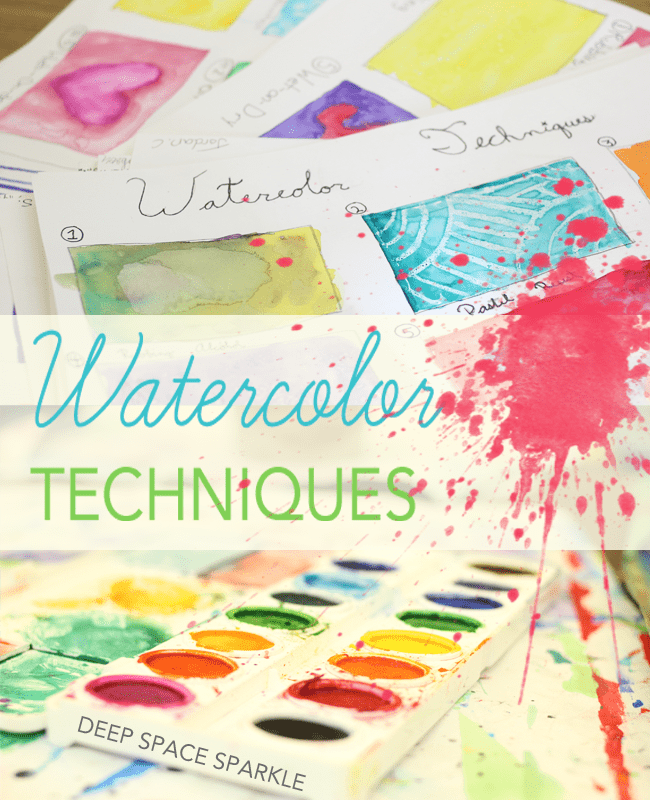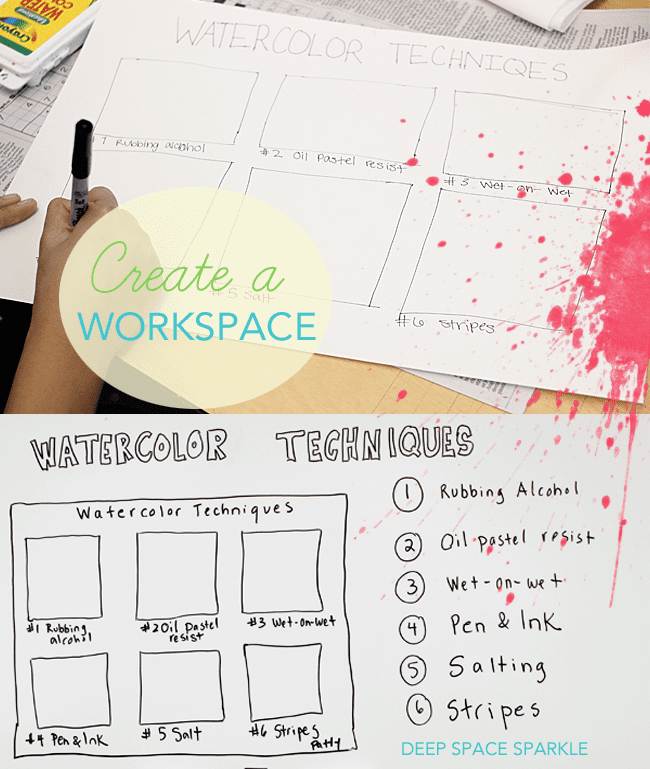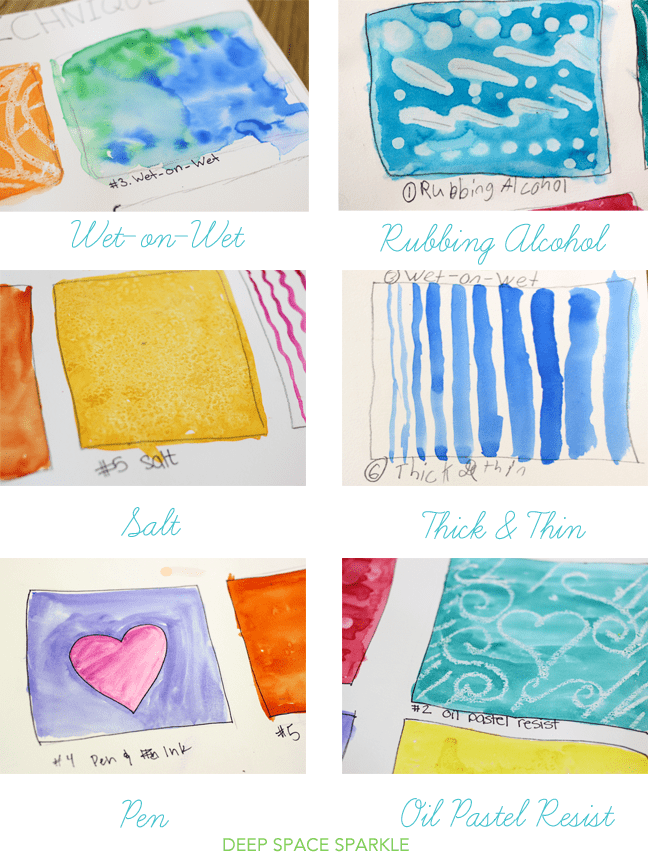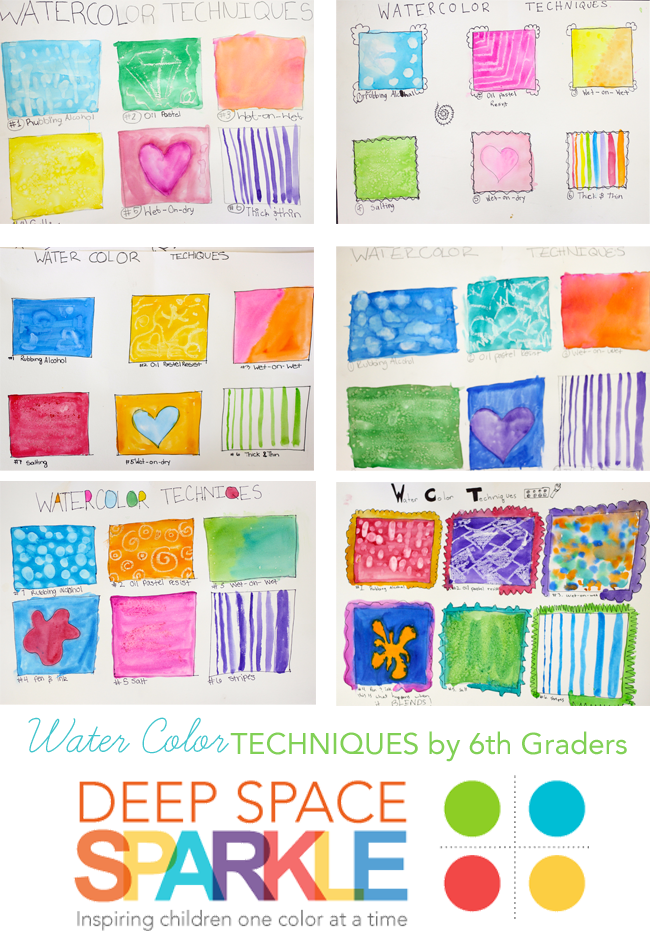Watercolor Painting Ideas Easy Watercolor Painting for Teachers
WATERCOLOR TECHNIQUES: A 6th GRADE EXPERIMENT

Building up to my sixth grade student's big unit on watercolors, I wanted to remind them of the various ways in which they can use watercolor paint. Even though I use watercolor techniques in every grade level and I have taught these children since first grade, it never hurts to remind the children, through their own experiments, of the unique qualities of watercolors.
To begin, each student received a 12″ x 18″ sheet of 90-lb watercolor paper, a tray of 16-color Prang watercolor paints, a waterproof marker, and a pencil and eraser. On the tables, I set a tray of oil pastels, some liquid watercolors (3 colors), a cup of rubbing alcohol and some Q-tips.
On the white board I illustrated where the title of the project should go and where to put the 6 experiment boxes. I encouraged the kids to use decorative writing and to create frames around their "experiment" boxes. Under each box, I asked them to write out the different techniques that we were going to try.

The first day, we managed to get our papers laid out with a title, the boxes and began 3 out of the 6 watercolor techniques.
The idea and hope behind this type of project is to focus on the process and not the result, although many children really turned this into a beautiful piece. For some kids, drawing rectangles placed evenly around the paper proved difficult while other students designed fancy frames and borders. You'll really notice how well children listen and also how creative they are during this process. I didn't fuss over how little or how much a student excelled at drawing the boxes or laying down text as it just wasn't the point. But I do have to say that it was interesting to see.

Wet-on-Wet
This is one of the most important watercolor techniques and effects in elementary art. It's important for children to understand the properties of watercolors and if they want a clean edge to their watercolor painting, then painting on wet paper is not the route to go. So often children can't understand why the paint blends together so much and doing this technique helps them learn this.
To start, the children painted their box with water then dropped some liquid watercolor on top of the wet surface. Some of my students took a painfully long time applying the water so this just shows how important understanding this technique really is. I encouraged the kids to apply two colors over the wet surface to see how the paint mingled.
Rubbing Alcohol
This technique is purely for fun. I don't use rubbing alcohol in my art room very often but it's fun to show how the alcohol expands and created a rubbery texture on the paper.
To start, paint a box with a dark color of paint from the paint tray. Then using a Q-tip dipped in rubbing alcohol, dab the paper. This creates rubbery dots that looks vaguely reptilian.
Salt
Most art rooms are familiar with salt as it creates such a beautiful effect. Many teachers use salting for underwater paintings.
To start, paint a box with any color of watercolor paint from the tray. Pinch some salt between your fingers and sprinkle a small amount over the paint. The salt will pull the water from the surrounding area creating a star burst effect. Brush salt away when the paint dries.
Thick and Thin
Although not exactly a technique, learning how to vary the thickness of a line with a paintbrush is pretty important. I instructed the children to use their fingers to gently squeeze the bristles into a fine point and then to dip just the point into some paint. With a very light touch, try drawing a straight line as thin as possible. Next, press a bit harder and see what happens to the line. The children can apply greater and greater pressure until they see the lines growing thicker.
Pen
As important as the wet-on-wet, painting right up to a pen or pencil line takes skill. This is a very hard technique to learn as children usually don't have the control or patience to make the colors set without mingling.
To start, draw a simple shape with a waterproof marker. Then dip paint brush in paint and paint around the contour line of the shape. Now fill in the center. By painting the contour line first, the paint will be the first to dry. Now paint the contour lines of the box and move the color towards the shape. The goal is to make sure the colors don't bleed together.
Oil Pastel Resist
Arguably the most common watercolor technique in the elementary art room yet this still results in ooh's and ahh's. Really.
To start, draw a pattern, lines, shapes, etc with an oil pastel then apply liquid watercolor over top.
I was so pleased with the enthusiasm level for this project. It also helped me see where my weaknesses are as a teacher; how well I explained one technique over the other. This is not necessary to grade, but this project can act as an assessment tool.
What do you think? Are there any techniques that you would cover in your elementary art room?

WATERCOLOR TECHNIQUES FOR KIDS
Click the image below to receive our free PDF lesson guide!
Source: https://www.deepspacesparkle.com/watercolor-techniques-a-6th-grade-experiment/
0 Response to "Watercolor Painting Ideas Easy Watercolor Painting for Teachers"
Post a Comment